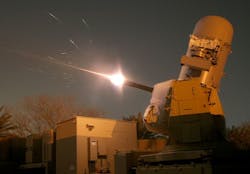It's fitting that military leaders should develop these kinds of technologies -- especially in this era where enemy threats to deployed warfighters can take so many forms, from conventional military forces to concealed terrorists who wield weapons ranging from improvised explosive devices (IEDs) to smart munitions.
It stands to reason that U.S. military forces have several systems deployed or in development to help form an umbrella of protection over vulnerable U.S. and allied warfighters who are operating close to the enemy and well within the range of most enemy weapons.
In development, for example, is the U.S. Air Force Raytheon Three-Dimensional Expeditionary Long-Range Radar (3DELRR) system to detect, identify, and track objects at great distances in conflicts that could involve large numbers of enemy advanced unmanned aerial vehicles (UAVs), fixed-wing aircraft, helicopters, and ballistic and cruise missiles.
Also in development is the U.S. Marine Corps Northrop Grumman Ground/Air Task-Oriented Radar (G/ATOR), which is designed to protect Marines on attack beaches from low-observable targets with low radar cross sections such as rockets, artillery, mortars, cruise missiles, and UAVs.
Northrop Grumman, moreover, is enhancing G/ATOR capability to counter enemy rockets, artillery, and mortars, which the military services call C-RAM.
Another battlefield radar system in development is the U.S. Army SRCTec AN/TPQ-49 and AN/TPQ-50 lightweight counter-mortar radar (LCMR) to help defend deployed warfighters from rocket, artillery, and mortar attacks using 360-degree surveillance and 3D rocket, artillery, and mortar location using non-rotating, electronically steered antennas.
The AN/TPQ-49 and AN/TPQ-50 systems both are designed to cover 360 degrees over a nearly 200-square-mile area. The systems can be adapted to cover narrower sectors at longer ranges, if necessary.
Related: Marine Corps orders nine more G/ATOR radar systems to protect warfighters on attack beaches
Already deployed is the U.S. Army Lockheed Martin AN/TPQ-53 radar system to protect soldiers from rockets, mortar rounds, and artillery shells. This radar also is designed to pinpoint the location of enemy launchers to direct counter-battery fire.
In addition to these and other battlefield air-defense and C-RAM radar systems, several Army and Marine Corps programs intend to fuse together data from these kinds of sensors and slave them to weapon systems layered from close-in to long-range distances to destroy or disable enemy airborne threats.
Northrop Grumman, for example, is providing hardware and services for Army C-RAM capabilities to protect brigade combat teams from enemy airborne attack. Northrop Grumman is integrating existing field artillery and air defense sensors, a commercial off-the-shelf (COTS) warning system, and a U.S. Navy-developed interceptor to protect forward-deployed warfighters from rockets, artillery shells, and rockets.
Lockheed Martin, meanwhile, is developing Extended Area Protection and Survivability (EAPS) Integrated Demonstration (ID) technology to counter incoming enemy rocket, artillery, and mortar rounds, as well as enemy cruise missiles and UAVs. Lockheed Martin experts are working on EAPS ID technology with the aim of moving it into an Army program of record for potential deployment within the next three years.
Related: Army to buy counter-mortar radars from SRCTec in potential quarter-billion-dollar contract
There are other military research projects that seek to fuse battlefield radar systems, other kinds of sensors, and weapons to enhance C-RAM capability.
One of these is the Office of Naval Research's Target Processing Center Sensor Correlation and Fusion project. This effort seeks not only to detect enemy artillery, rocket, and mortar rounds and reduce false alarms, but also to speed counter fire to destroy enemy projectiles, artillery emplacements, and launchers.
This sounds like a lot of different sensor, sensor-fusion, and weapons projects, all intended to protect military forces from ... you guessed it ... rockets, artillery, and mortars. I'm not suggesting this is a bad thing.
I do wonder, however, if U.S. military C-RAM efforts might be duplicative or otherwise wasteful.
I fully realize that military experts, far more intelligent and learned than I, could sit me down and explain convincingly how all these separate projects and systems are essential for keeping our deployed warfighters safe on the leading edge of the battlefield, and they might just be right.
Still I wonder if there's any way that at least some of the enabling technologies of these different programs could be combined to enhance efficiencies, while not compromising on capabilities. For a new U.S. president who's just itching to remake a lean and mean military that gets the most bang for its buck, this is something to think about.
Learn more: search the Aerospace & Defense Buyer's Guide for companies, new products, press releases, and videos

